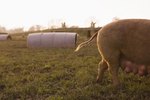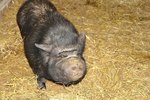Cows, pigs, sheep, chickens and goats are staples of childhood learning through toys, educational television shows and cartoons. However, there is more to know about these animals than just the sounds they make and the way they look. Whether you are taking a class trip to a farm or just want to entertain your kids, fun facts about farm animals can leave a lasting impression.
Pigs

Most kids know that pigs like to roll around in mud, but they may not know pigs do this to cool off because they don’t sweat. Despite being stereotyped as dirty, pigs are actually rather clean. Given enough space, pigs will relieve themselves as far from their sleeping area as possible. Like puppies, young pigs enjoy playing with toys and with other piglets. They also like being around people and enjoy a good scratch behind the ears or on the belly. While pigs prefer to spend the majority of their day at rest, they are capable of running roughly 11 miles per hour. Pigs also communicate with each other using more than 20 different noises.
Cows

Just like pictures that children draw of cows, every cow’s pattern of spots is different. A male cow’s horns feature rings, the number of which roughly equals its age. Don’t assume a cow is tired or lazy because it is lying down. This is sometimes a reaction to a change in atmospheric pressure before a storm. With a sense of smell so strong, cows are able to detect scents up to five or six miles away. Like many domesticated pets, cows learn and react to the names they are given by people. They are even known to form cow “cliques” within the herd.
Sheep

Although one sheep may look like any other to a person, members of the same flock have been known to recognize one another even after years of separation. A flock is a social group and a defense mechanism, facing threats together. When a sheep’s fleece is shaved, it must be done in one piece, with the person doing it also holding the sheep still.
Goats

Female goats have beards, just like the males. Some are born with horns and, much like human fingernails which are made of the same material, the horns continue to grow for the goat’s entire life. Goats are not only skilled swimmers; they can also climb trees and traverse a ledge as deftly as a circus high-wire performer.
Chickens

“Cock-a-doodle-do” is often one of the first sounds that toddlers learn. The rooster’s crow that signals the sunrise may be heard before any light is seen as chickens spot the break of light almost an hour before people do. Groups of chickens that live freely establish an order of importance among themselves to determine who eats first and who sleeps where. Chickens wash with dust rather than water and clean their feathers with their beaks.
References
Photo Credits
-
Jupiterimages/Pixland/Getty Images
Writer Bio
Kathy Mair has been writing professionally since 1994. As a member of the Kinston Indians front office, she was responsible for all team press releases and articles, a duty she subsequently held for two other minor league baseball teams. Mair also spent time as a copy editor for "TV Guide." She holds a Bachelor of Arts in communications from Elizabethtown College.




